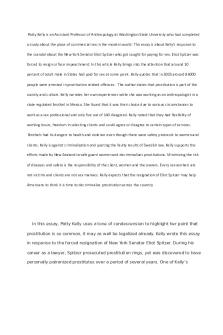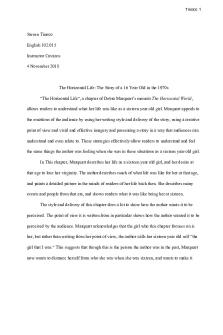ENG 110 Rhetorical Analysis- Family Guy PDF

| Title | ENG 110 Rhetorical Analysis- Family Guy |
|---|---|
| Course | First-Year Composition |
| Institution | California State Polytechnic University Pomona |
| Pages | 3 |
| File Size | 73.8 KB |
| File Type | |
| Total Downloads | 8 |
| Total Views | 150 |
Summary
Class Assignment...
Description
Booker 1
Symone Booker Professor Bening ENG 110- 04 14 April 2015 Rhetorical Analysis on “Family Guy and Freud: Jokes and Their Relation to the Unconscious” 1. The Situation: Antonia Peacocke was moved to write based upon the misconception that the television show Family Guy is faced with. Peacocke mentions that before she became a fan of the show she didn’t understand how people who did watch it could laugh “at something so blatantly sexist...and failed to see how anyone could laugh at such jokes without feeling at least slightly ashamed” (260). In seeing that she wasn’t alone with her opinion on the show, “it will come as no surprise that I was not alone in this view; many still denounce Family Guy as bigoted and crude” (258) she later forced herself to watch it due to all of the success and support that it was receiving, perhaps to see if her and her fellow critics were missing something. As she noted, Stephen Dubner (a critic of Family Guy) who admitted to not watching the show is able to “easily come to think that the cartoon takes pleasure in controversial humor just for its own sake” (261). Peacocke does not try to defend the show on matters of if it is moral or not, but rather it’s purpose that MacFarlane created it for, which was based on him “want[ing] only to amuse [his audience]” (265). 2. The Writer’s Purpose: Peacocke thinks that everyone should think of Sigmund Freud when watching their shows on television. “Whether you’re watching Living Lohan or the NewsHour, the likelihood is that you are not thinking of Sigmund Freud...I say that you should be” (257). Peacocke makes the argument that without paying attention to the jokes being made on the show, you can miss their intentions or messages. “But those who pay more attention and think about the creators’ intentions can see that Family Guy intelligently satirizes some aspects of the American culture” (261). She concludes why recognizing these jokes and their distinctions are important, so that the audience or viewers know when to draw the line on what is truly funny and what is hurtful. “It’s important not to lose sight of what’s truly unfunny in real life - even as we appreciate what is hilarious in fiction” (266). 3. The Writer’s Claim: Peacocke’s main claim is that we as viewers should not just watch a television show
Booker 2
mindlessly without thinking in the ways of Freud and considering the message it may be sending to us. She wants us to think about the reasons behind some jokes that are said or actions that are performed to see “whether or not these... exist for a reason” (266). Although Peacocke loves the show and thinks that it “has its intelligent points, and some of its seemingly ‘coarse’ scenes often have hidden merit” (266), she also recognizes that “sometimes the creators do seem to cross...the line of indecency” (266). I think that this shows light on Peacocke’s main claim that if we were to simply watch a show without posing questions or considering what it is telling us, that we could miss some issues that it poses in our society as well as some material that we may find unnecessary for the show to include. 4. The Writer’s Audience: a. Language: Peacocke used a mixture of formal and informal language in her essay, for she made it clear that this was an academic essay however she included words such as “you” and “I” which make the essay seem more personal and informal. Within her first paragraph, Peacocke makes it relatable to her audience by saying, “while slouching in front of the television after a long day, you probably don’t think a lot about famous psychologists of the twentieth century” (257). She even goes so far as to connect to the reader by offering the interaction of her friends when she says, “any of my friends can tell you that this program holds endless fascination for me” (258). The use of “I” makes it more informal for it gives the reader the sense that she is telling you a story about her feelings towards Family Guy. An example of this is when she began to like the show and she says, “with more exposure, I found myself crafting a more positive view of Family Guy” (261). Although there are a handful of examples of informal language in her essay, which intrigue the audience and make them feel included in an essay, there was more formal language with references to other sources and facts. b. References: Peacocke uses quotes and statistics from multiple sources to help support her claims. When she was in congruence with Dubner about the crudity and offensiveness of Family Guy, she stated that she agreed or rather was not alone in her views for Dubner saw it as ‘“a cartoon comedy that packs more gags per minute about race, sex, incest, bestiality, etc. than any other show [he] can think of”’ (258). In addition to quoting people, Peacocke also used cites such as Facebook for statistical information such as the
Booker 3
number of fans and supporters Family Guy has, “there are currently 23 separate Family Guy fan groups with a combined membership of 1,669 people” (261). Peacocke even used words from Freud, who obviously didn’t say anything directed at Family Guy, nonetheless still helping Peacocke make her point. For Peacocke says, “if we listen to Freud, [the funniest jokes] are the ones that let our animalistic and aggressive impulses surface from the unconscious” (266). It is important that she used multiple sources to make references because it gives her essay and opinions more credibility than if she were to only quote 1 or 2 people that share the same opinion as her compared to her quoting different points of views and then stating why she finds her view correct. c. Structural Construct: Peacocke has a few structural constructs that stand out from her essay which make it different from most. As you read along in her essay, you will come across a section where she has entered commentary from the show as an example to support one of her claims. She sets up the picture for the reader and then gives the commentary of what the characters say and do; an example is seen on page 260. Peacocke also tends to add parentheses throughout the essay to emphasis or give her opinion on an idea or fact within her essay. An example of this is “Take, for instance... fourth-season episode, ‘PTV.’ (Never mind that a dog and a baby can both read and hold lengthy conversations)” (261). Peacocke seemed to structure her essay in sections such as she started with a personal introduction, lead into statistics of the show, followed by critics and opinions of the show, and concluded with a defense and explanation of the show. The importance of these structures is that they change the formality and how the audience relates and connects to the essay....
Similar Free PDFs

Essay 2 eng 110
- 3 Pages

Rhetorical Analysis
- 5 Pages

Rhetorical analysis
- 2 Pages

Puppy Rhetorical Analysis
- 4 Pages

Rhetorical analysis -1
- 4 Pages

Bowling Dana Rhetorical Analysis
- 4 Pages

Rhetorical Analysis Essay
- 5 Pages

Textual Rhetorical Analysis
- 3 Pages

Rhetorical Analysis Final
- 5 Pages

Rhetorical Analysis Prompt
- 2 Pages
Popular Institutions
- Tinajero National High School - Annex
- Politeknik Caltex Riau
- Yokohama City University
- SGT University
- University of Al-Qadisiyah
- Divine Word College of Vigan
- Techniek College Rotterdam
- Universidade de Santiago
- Universiti Teknologi MARA Cawangan Johor Kampus Pasir Gudang
- Poltekkes Kemenkes Yogyakarta
- Baguio City National High School
- Colegio san marcos
- preparatoria uno
- Centro de Bachillerato Tecnológico Industrial y de Servicios No. 107
- Dalian Maritime University
- Quang Trung Secondary School
- Colegio Tecnológico en Informática
- Corporación Regional de Educación Superior
- Grupo CEDVA
- Dar Al Uloom University
- Centro de Estudios Preuniversitarios de la Universidad Nacional de Ingeniería
- 上智大学
- Aakash International School, Nuna Majara
- San Felipe Neri Catholic School
- Kang Chiao International School - New Taipei City
- Misamis Occidental National High School
- Institución Educativa Escuela Normal Juan Ladrilleros
- Kolehiyo ng Pantukan
- Batanes State College
- Instituto Continental
- Sekolah Menengah Kejuruan Kesehatan Kaltara (Tarakan)
- Colegio de La Inmaculada Concepcion - Cebu





